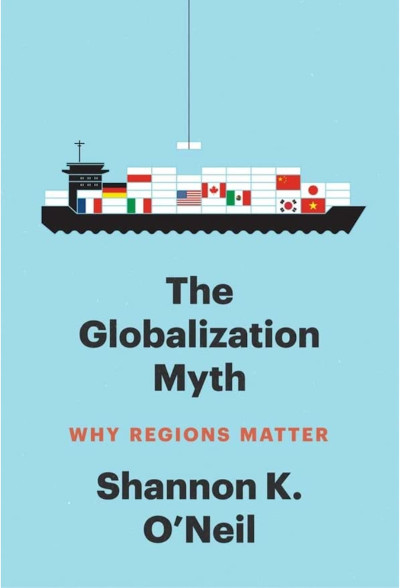In the picture
Cover of Shannon K. O'Neil's book 'The Globablization Myth. Why Regions Matter' (New Haven: Yale University Press, 2022) 230 p.
Shannon O'Neil of the U.S. Council on Foreign Relations does not question the fact that in recent decades the trade of almost all countries has expanded in all four corners of the world, but warns that the greatest trade growth has been with countries closer to or in the same region. It is not that now, with the transcontinental supply chains affected by the pandemic and the slowdown of the Chinese Economics , many countries are seeking refuge in the 'near abroad', but that even before this more recent trend, what has really taken place in the world was regionalization (and not globalization).
"Yes, the world has internationalized. But it hasn't really globalized. It has regionalized," says O'Neil. Certainly, "the story of economic globalization has been told over and over again in books, speeches, articles and news stories. However, this conventional narrative largely loses sight of the geographic boundaries of most international trade"; "the better term for what is happening on the global Economics is 'regionalization,' rather than 'globalization.'"
The author argues that this regionalization has mainly taken place in three hubs: the European Union, Asia-Pacific and, to a lesser extent, North America. And here we come to the real purpose of the book: to defend the convenience of a greater link between Canada, the United States and Mexico. O'Neil is part of the group study group that, within the Council on Foreign Relations in the United States, promotes the idea of North America as a space for integration. He admits that this is not a popular idea among his fellow citizens, but argues that only through a confluence with its two neighbors can the United States be in a position to take advantage of the challenges of the coming decades.
In three chapters, O'Neil analyzes trade in Europe, Asia and North America and demonstrates with figures how trade and the production chains of large and medium-sized companies have become regional, fueling the important development of their respective societies since the end of the last century. The main effort is devoted to defending the North American Free Trade Agreement (NAFTA), known since 2020 as T-MEC in Mexico or USMCA in the United States. He warns that if the results have not been incontestably positive, it has been due to not having played the regional card to the full, due to the "reluctant regionalism" of North America. Without the US reluctance to further integration with its neighbors and without their fear of absorption by the US, O'Neil believes, prosperity in North America could be greater today.
The author regrets that the progress that the negotiation of the Treaty and its implementation in 1994 meant for North American convergence was soon limited to economic aspects, without exploring other fields to which the door then seemed to be open. "In the end, the three nations could not overcome the isolationist forces in their respective political cultures" and all three countries "were strongly opposed to creating continental institutions." In the end, the treaty has remained a "mere trade agreement ," without giving way to another subject of joint decisions as in the EU (whose model, in any case, was never the goal) or even ASEAN.
The numbers O'Neil presents indicate that, counting jobs lost and gained by the US since 1994, it could be said that the Treaty had "little or no effect on employment overall" (most of the US job loss and deindustrialization would have occurred rather with China's entrance in the WTO). Trade has so little weight in the huge US Economics that the Treaty made a big difference; however, beyond the quantification of jobs work, O'Neil stresses that without the Treaty the US Economics would not have advanced as far, as offshoring component production to Mexico allowed US firms to be able to compete with foreign firms that exploited cheap labor from Eastern Europe and Asia. Without the Treaty, "many jobs that stayed would have left as well, and new jobs that were created would never have appeared".
The book ends with the chapter "More NAFTAs and fewer American Firsts', which is a call to the US political class to leave behind the reluctance in trade liberalization with Canada and Mexico, as well as certain autarkic dynamics seen in the Trump era. He presents it as the best strategic bet for the future for the US. "The US will not compete effectively on the world stage if it does not embrace its neighbors," he concludes.
Among the few concrete aspects he proposes along these lines is the simplification of administrative procedures (some have actually become more complicated with the new version entrance in force in 2020, by increasing the percentages of the rules of origin in sectors such as the automotive industry, the sector that has benefited the most from the Agreement). O'Neil notes that almost half of the products going from Mexico to the U.S. do not go through the treaty to avoid the complicated bureaucracy.
The work does not explore more options in the process of regionalization of North America, which is limited to the three countries of the current Treaty. It takes into account Central America as a place of support for the expansion of the production processes of North American companies, but hardly touches on more ambitious steps, such as a closer association with Colombia and the Dominican Republic (in fact, there is already a free trade framework of Central America and these other countries with the USA). In any case, aware that "for now, a united continent remains a distant possibility", O'Neil fulfills his single mission statement to encourage discussion in the United States about the need to open up more to his region.

